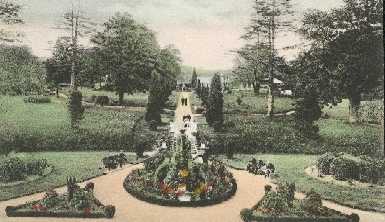
Belmont Park

Richard and Scales Map of 1776 shows the existence of a building on or close to the site of the present building. The property was referred to as Mount Hulings. It is established that a family of Hulings lived there. In 1753 a John Hulings was a witness of a lease arrangement between
Sid ???? & Robert Snow and the farmers of Kilmurry.
In 1789 William Anthony (Jnr.) designed the Belmont mansion. It was probably built for a member of the Newport family – likely William Newport, the Banker. He ended his own life at Belmont – it is said he faced bankruptcy and could not deal with the situation.
Shortly afterwards Henry Winston Barron took up residence in Belmont and changed the name to Barroncourt. That name remained on the residence while he was there and during the residence of his successor, Pierce Marcus Barron. Belmont Park was put up for sale in 1881. At the time Dr. Abraham Browning, Bishop of Ossory, invited the Brothers of Charity to come to Ossory to open a foundation for the treatment and care of mentally sick patients. Later that year the Superior General of the Order and Canon de Groote, Spiritual Director of the congregation, arrived to inspect the buildings and grounds. On examination it was discovered that the building was in need of major repairs. Eventually the property was purchased for £600 in 1883. The roof was replaced and extensive work had to be done to the foundations. The contractor was Mr. Hearne of Waterford. This work cost a further £600.
The religious ceremony of taking possession of the property was performed on May 1st 1884. New extensions were built in the following year under the direction of the Superior Rev. Brother Wenceslaus Becker.
At Easter 1885 the local paper carried an advertisement for the hospital – Saint Patrick’s Hospital for the Insane, under the care of the Brothers of Charity, was now in a position to accept patients. The first private???? Hospital of its kind in the country, it claimed to be equipped to the highest standards.
The first patient, a priest from the Diocese of Ossory, had been accepted in May 1884. By 1908 the hospital was licenced to have 73 patients. The next building constructed??????? was the chapel, which still exists. It was blessed and opened in 1927.
Disaster struck in 1949 on 10th December at 1.10 a.m. Fire had broken out in St. Mary’s Wing and the alarm was raised using the chapel bell to rouse everyone. Most of the building was gutted but the patients and members of the community escaped unharmed. The current statue of St. Patrick standing over the front entrance escaped damage as the building around it was gutted. Work commenced on replacing the hospital building in 1951 and was completed in February 1954. In the interim, for a short period, patients were accommodated in St. Otteran’s and some in the present St. Michael’s building. Large wooden huts with individual rooms were built on the tennis court to accommodate the community and patients until the hospital was ready.
In tandem with the psychiatric services in 1965 a residential service was established for male adults with intellectual disability at St. Michael’s, Belmont Park, and in 1982 the first community based group home was opened. Since then these services have gone from strength to strength. On the contrary, the psychiatric services and a specialist alcoholism treatment centre was axed in 1991 as a stage had been reached when the continuance of such services seemed in conflict with the ethos and vision of the Brothers of Charity Congregation. A huge financial input was required to upgrade the facilities to compare with the private hospitals in Dublin and the congregation felt that there were adequate resources and facilities in the country already in the area of psychiatry.
Their ethos was to care for the marginalised and to leave each individual live life to their full potential and the decision was taken to concentrate on the Mental Handicap Services.
Today – 2000- Brothers of Charity Services is one of the larger service providers in the South Eastern Region, offering residential and day services to persons with intellectual disability in Waterford City and County and in Tipperary South Riding. Over three hundred adults and children avail of the services on offer and in excess of 250 staff are employed directly in service provision and administration. There is an emphasis on community based services and the development of small enterprises that offer real work opportunities for people with intellectual disability in an environment that paces itself to the needs of the person with intellectual disability rather than to the commercial pressures of regular businesses.
The members of the Brothers of Charity Congregation are no longer involved in the day-to-day administration of the services but work at a governance level.